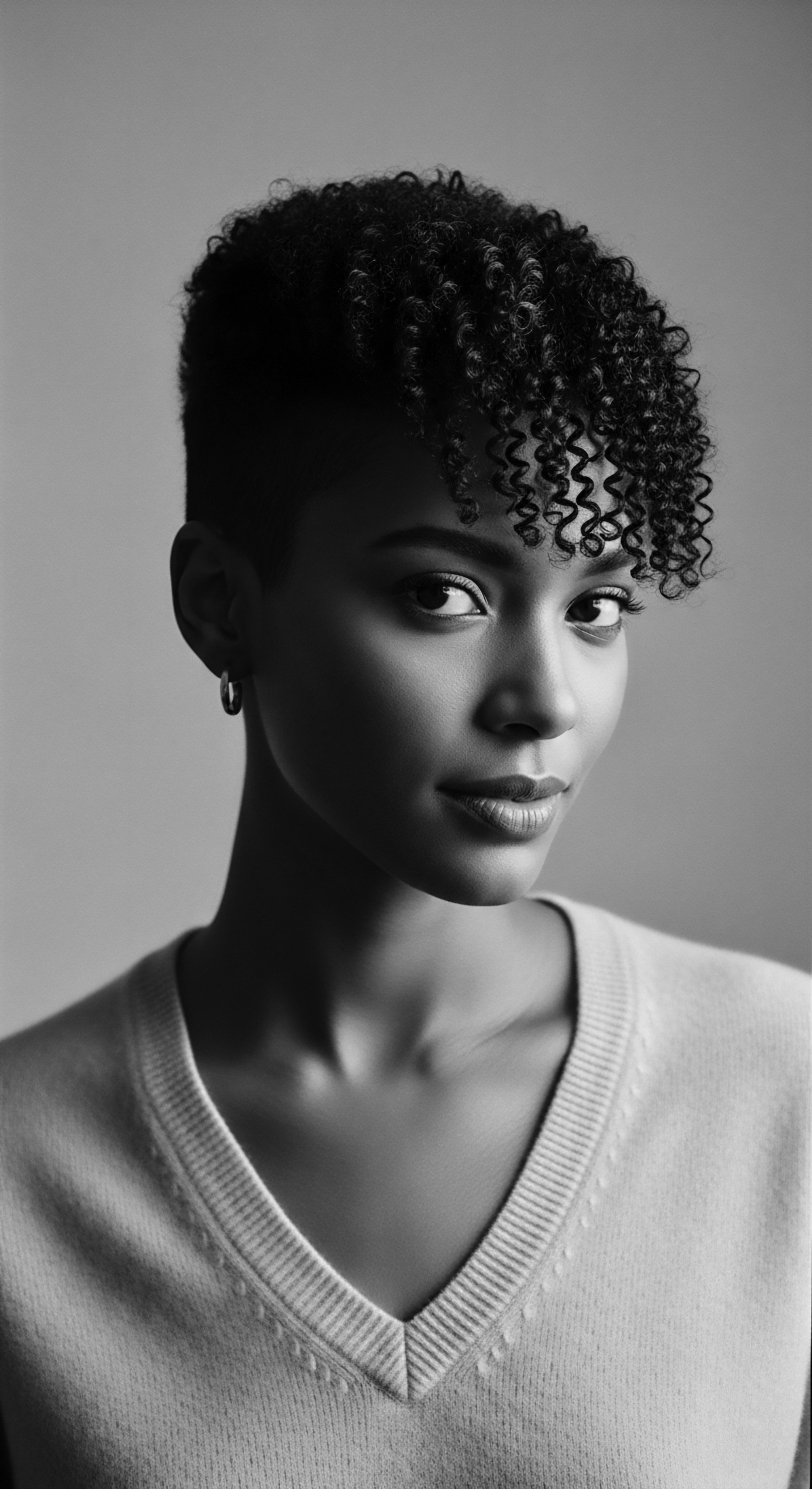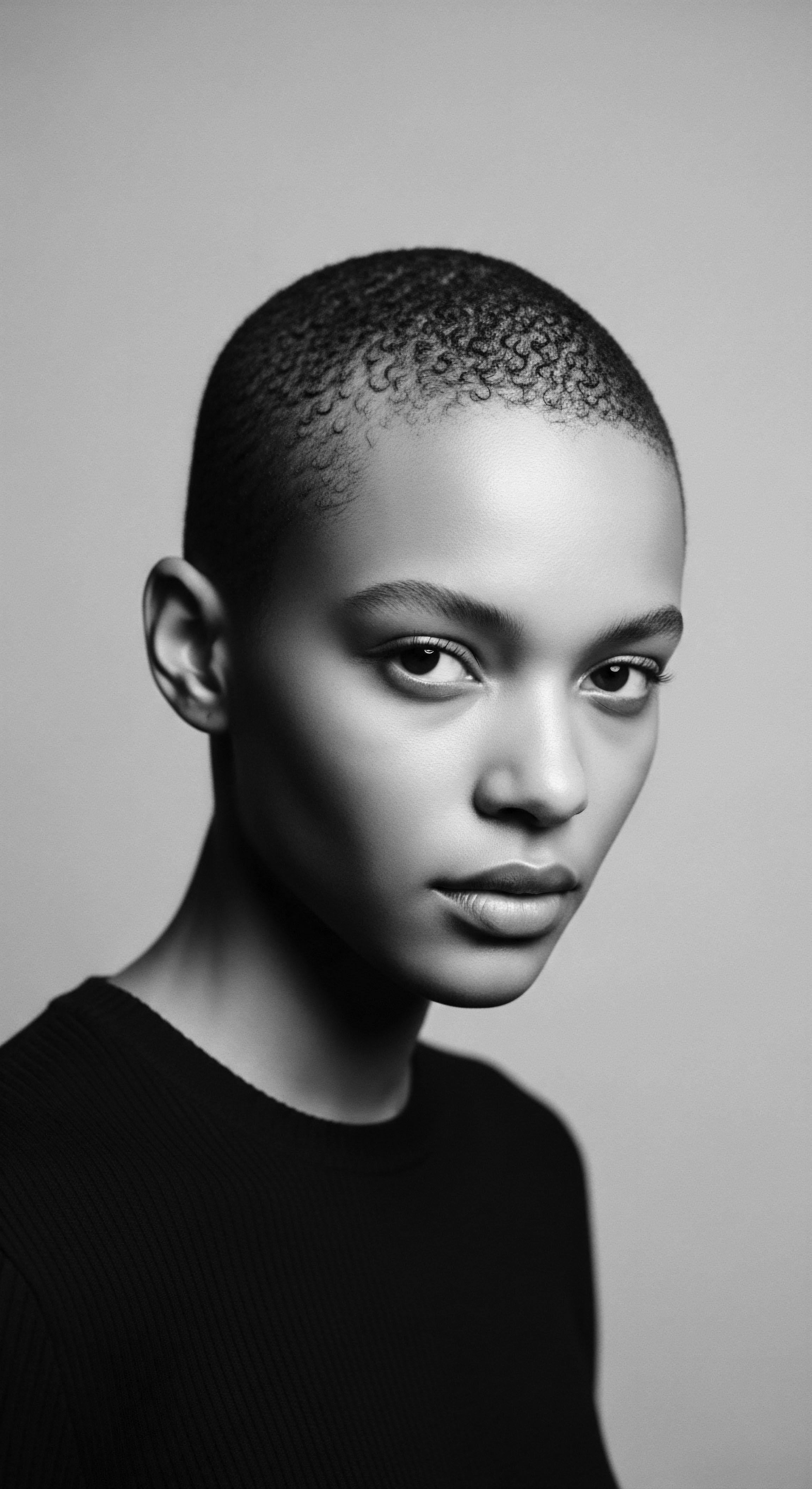
Roots
Consider for a moment the gentle whisper of generations past, carried on the very strands of our hair. For those with coils, kinks, and waves, hair is seldom simply a biological outgrowth. It is, and always has been, a testament to resilience, a chronicle of identity, and a vibrant link to ancestral narratives.
The question of whether ancient hair cleansing methods might mend the modern scalp’s woes for textured hair invites a deeper contemplation, a looking back to the earth-rooted wisdom that once guided every aspect of life, including the tending of our crowns. It is a dialogue between the elemental makeup of our strands and the time-honored practices that once honored them.
Centuries ago, long before the advent of chemical concoctions and synthetic foams, communities across continents fostered ingenious ways to cleanse, nourish, and protect their hair. These methods were born of necessity, certainly, yet they flourished from an intimate kinship with nature, a profound understanding of botanical properties, and a shared communal knowledge passed down through the ages. For textured hair, with its unique structure and inherent tendencies towards dryness, these practices held particular significance.
The tightly wound helix of a coily strand, while beautiful, makes it susceptible to tangling and limits the natural oils’ journey from scalp to tip. The ancestral approaches, however, often addressed these inherent qualities with an intuitive grace.

The Sacred Anatomy of Textured Hair
To truly grasp the wisdom held within ancestral cleansing, one must first understand the very fabric of textured hair itself. Each strand is a wonder, a complex protein filament emerging from the scalp’s follicle, yet its journey is distinct. Unlike straight hair, which tends to grow uniformly round, textured hair often exhibits an elliptical shape, contributing to its curl pattern. This shape, combined with the presence of disulfide bonds and hydrogen bonds, creates the characteristic bends and twists we celebrate.
The cuticle, the hair’s outermost protective layer, tends to be more open or raised in textured hair, making it more prone to moisture loss and dryness. This porosity, while a challenge in modern contexts, was intuitively managed by traditional caregivers.
Ancestral communities observed these tendencies keenly. Their practices were not random acts but careful responses to the hair’s fundamental needs. They sought ways to cleanse without stripping, to restore rather than deplete.
The aim was always to sustain the hair’s innate vibrancy, maintaining its moisture balance and the scalp’s ecological health. This intimate relationship between understanding hair’s biology and devising care routines forms a central pillar of our heritage in hair wellness.
Ancient hair care was an intuitive science, a heritage born of observation and deep respect for textured hair’s intrinsic nature.

Ancestral Observances and Scalp Ecology
The scalp, often overlooked in modern routines focused solely on the strands, held a place of reverence in many ancient cultures. It was recognized as the soil from which the hair grew, requiring diligent care for healthy growth. Traditional cleansing was thus a holistic act, treating both hair and scalp with equal consideration. Practices often involved gentle stimulation, exfoliation, and the application of nourishing substances derived directly from the earth.
- Botanical Cleansers ❉ Substances like saponins from soap nuts (Sapindus mukorossi) or shikakai (Acacia concinna) pods, prevalent in South Asian traditions, offered a mild, non-stripping cleanse, respecting the scalp’s delicate microbiome.
- Clay Formulations ❉ Ghassoul clay, originating from the Atlas Mountains of Morocco, used for centuries, possesses remarkable absorptive properties, drawing out impurities from the scalp without harsh detergents, leaving both hair and skin soft.
- Fermented Grains ❉ In some African lineages, fermented rice water, its history stretching back centuries, was not only a rinse but a mild scalp purifying agent, its amino acids thought to contribute to strength and sheen.
These ingredients, chosen for their inherent properties, were applied with a wisdom that recognized the interconnectedness of scalp health, hair vitality, and overall wellbeing. They represent a counter-narrative to the harsh, often stripping cleansers that became commonplace in the industrial age, offering a softer, more symbiotic approach to scalp cleansing. The deep knowledge of these plants and their applications was a legacy, a living archive transmitted through oral tradition and practical demonstration within families and communities.

Ritual
The act of cleansing hair, in many ancient societies, transcended mere hygiene; it was a ritual, a communal undertaking, a sacred moment connecting individuals to their lineage and the natural world. These rituals, infused with intention and ancestral wisdom, offer profound insights into whether these methods can, in fact, improve scalp health for textured hair. The practices were often slow, deliberate, and layered, allowing for the gentle unfolding of purification and nourishment. This approach stands in stark contrast to the rapid, often aggressive cleansing prevalent in many contemporary routines.
Consider the collective memory held within the diaspora, a memory that recalls practices of hair care as central to family and community life. In many West African societies, for example, hair braiding and cleansing were often intergenerational activities, shared moments where stories were exchanged, wisdom imparted, and bonds fortified. The elders, the keepers of knowledge, would guide the younger hands through the meticulous steps of preparing botanical ingredients, of applying them with mindful touch, and of understanding the hair’s responses. This context of care, steeped in familial connection, is as vital as the ingredients themselves when considering the efficacy of these methods.

The Rhythmic Application of Ancestral Cleansers
The application of ancient cleansers was rarely a hurried affair. It was a rhythmic dance between hands and scalp, an opportunity for observation and connection. Preparations might involve grinding herbs into powders, infusing oils, or steeping barks.
The resulting pastes or liquids would be massaged gently onto the scalp, allowing the active compounds to interact with the skin. This massage not only aided in the distribution of the cleanser but also stimulated blood flow to the hair follicles, a fundamental aspect of scalp health that modern science continues to affirm.
For instance, the use of aloe vera, native to Africa and other warm climates, as a cleansing and soothing agent has deep historical roots. Its mucilaginous gel, when applied to the scalp, can offer hydration and possess mild antimicrobial properties. Combined with a gentle finger massage, it helps dislodge flakes and build-up without stripping the scalp’s natural lipid barrier. This contrasts sharply with harsh sulfate-laden shampoos that can disrupt the scalp’s delicate pH and strip it of essential moisture, leading to dryness and irritation, particularly for textured hair.

Honoring the Scalp’s Ecosystem
The concept of a balanced scalp ecosystem, while a contemporary scientific term, was implicitly understood by ancestral healers. They recognized that a healthy scalp was not merely clean but vibrant, able to support robust hair growth. Their cleansing agents, often naturally low-foaming, honored this delicate balance.
They did not aim to sterilize the scalp, but to purify it, allowing beneficial microbes to thrive while addressing impurities and imbalances. This often meant opting for substances that worked in harmony with the skin’s natural defenses.
| Traditional Agent Shikakai Pods |
| Origin/Historical Use South Asia, centuries of use in Ayurvedic tradition |
| Scalp Benefit (Ancestral Understanding) Mild cleansing, detangling, cooling sensation, hair growth. |
| Modern Scientific Parallel Saponins for gentle surfactant action, low pH for cuticle smoothing. |
| Traditional Agent Rhassoul Clay |
| Origin/Historical Use North Africa (Morocco), used since 8th century for skin and hair. |
| Scalp Benefit (Ancestral Understanding) Purifying, detoxifying, softening, mineral replenishment. |
| Modern Scientific Parallel High mineral content (silica, magnesium, calcium) for absorption of impurities and remineralization. |
| Traditional Agent Aloe Vera Gel |
| Origin/Historical Use Africa, Caribbean, widespread historical use as a healing plant. |
| Scalp Benefit (Ancestral Understanding) Soothing, moisturizing, wound healing, promoting healthy skin. |
| Modern Scientific Parallel Polysaccharides and glycoproteins with anti-inflammatory and hydrating properties. |
| Traditional Agent These ancestral ingredients offer a legacy of gentle care, supporting a balanced scalp environment for textured hair. |
One powerful instance of ancient wisdom translating into modern understanding can be seen in the use of specific plant infusions. For generations, communities utilized infusions of plants like stinging nettle or rosemary, which were often massaged into the scalp during cleansing. While the exact scientific mechanisms were unknown, observations clearly indicated improved scalp condition and hair vitality.
Modern research now acknowledges the anti-inflammatory, antioxidant, and circulation-boosting properties of these botanicals, supporting their traditional applications for issues such as dandruff and hair thinning. (Sivakumar, 2011) This convergence of heritage and contemporary understanding underscores the value of looking back.
The rhythmic nature of ancient cleansing transformed a task into a sacred ritual, nurturing not only the hair but the spirit.

Relay
The question of whether ancient hair cleansing methods can truly mend the modern scalp for textured hair moves beyond simple anecdotal evidence; it calls for a deeper look into the intricate connections between time-honored practices, the specific needs of textured hair, and contemporary scientific validation. This is a relay race across generations, where ancestral knowledge passes the baton to current understanding, illuminating pathways to improved scalp health that are both authentic and efficacious. It challenges us to reconsider the very definition of “clean” and to prioritize equilibrium over sterile stripping.
For generations, particularly within Black and mixed-race communities, hair has been a canvas for identity, resistance, and a living record of collective experience. The practices of hair care, including cleansing, were never divorced from this deeper cultural resonance. When modern commercial products began to dominate, often formulated without consideration for the unique needs of textured hair, many traditional practices were marginalized. Yet, the persistent issues of dryness, breakage, and scalp irritation among those with textured hair suggest that the aggressive detergents common in conventional shampoos may indeed be counterproductive, hinting at a wisdom in the ancient ways that prioritized gentle, nourishing care.

Can Modern Science Validate Traditional Cleansing Practices?
Contemporary trichology and dermatology are increasingly recognizing the importance of a healthy scalp microbiome – a balanced community of microorganisms that protect against pathogens and maintain skin integrity. Many ancient cleansing methods, by their very nature, were less disruptive to this delicate ecosystem than harsh synthetic surfactants. Ingredients like soap nuts, often used in Indian subcontinental practices, produce a mild foam due to natural saponins, cleansing without completely denuding the scalp of its protective lipids. This minimal disruption helps preserve the microbiome, potentially preventing issues such as dandruff, seborrheic dermatitis, and dryness, which are particularly common among individuals with textured hair.
The humectant and emollient properties of plant-based cleansers, such as those derived from okra pods in some West African traditions, were also key. These substances not only cleanse but also provide a slip that aids in detangling, a critical step for textured hair prone to knots and breakage. This detangling action, performed during the cleansing process, minimizes mechanical stress on the hair strands and follicles. Scientific analysis now reveals that the mucilage from okra contains polysaccharides that can coat the hair, reducing friction and aiding manageability.
This synergy of cleansing and conditioning is a hallmark of many ancestral methods. (Okereke & Uzomah, 2009)

Reclaiming Cleansing for Scalp Vitality
The journey back to ancient cleansing is not about an uncritical return to the past. It is about discerning the principles that made these methods effective and integrating them with contemporary knowledge. It calls for a conscious shift away from the belief that ‘squeaky clean’ implies health.
For textured hair, ‘squeaky clean’ often means dry, brittle, and vulnerable. Instead, the wisdom of our ancestors points towards a clean that feels balanced, supple, and nourished.
For instance, the historical use of dilute acidic rinses, such as apple cider vinegar, common across various ancient cultures, aligns with modern understanding of pH balance. The scalp’s natural pH is slightly acidic, which helps maintain the skin barrier and inhibit the growth of certain microbes. Many traditional cleansers, being plant-derived, often have a pH closer to this natural range, or they are followed by rinses that restore the scalp’s acidic mantle. This pH harmony is vital for preventing irritation and supporting a thriving scalp environment for textured hair.
Ultimately, the enduring legacy of ancient cleansing methods for textured hair lies in their inherent gentleness and their respect for the hair’s natural state. They offer a blueprint for care that prioritizes holistic health, working with the hair’s intrinsic qualities rather than against them. It is a powerful reminder that sometimes, the most profound answers lie in the echoes of our past, waiting to be rediscovered and rewoven into our present. The wisdom carried through generations, the deep understanding of botanicals, and the cultural context of care present compelling evidence that these ancient practices can indeed usher in an era of improved scalp health for textured hair, connecting us ever more deeply to our strands’ ancestral story.
The ancient paths to cleansing, rooted in reverence for the scalp’s natural balance, offer a potent remedy for modern scalp concerns.

Reflection
The lineage of textured hair care stretches back through time, a continuous thread woven with ingenuity, necessity, and profound cultural significance. Our exploration of whether ancient cleansing methods might indeed mend the modern scalp for textured hair reveals more than just a collection of historical practices; it uncovers a philosophy of care, a legacy of understanding that speaks to the very Soul of a Strand. These methods, born from an intimate rapport with the earth and a deep respect for the body, offer not simply alternatives, but perhaps foundational truths about nurturing our hair.
They remind us that true scalp health for textured hair is not an endpoint of chemical intervention, but a harmonious state achieved through gentle stewardship, patience, and connection to a heritage of wisdom. The ancestral paths whisper to us, inviting a return to simpler, more attuned rhythms of care, where the act of cleansing becomes a mindful dialogue with our past, present, and the unbound helix of our future.

References
- Sivakumar, M. (2011). Herbal Hair Care. In ❉ Indian Medicinal Plants. Springer, New Delhi.
- Okereke, E. and Uzomah, A. (2009). The potential of plant mucilage in hair cosmetics. International Journal of Cosmetic Science, 31(2), 105-110.
- De la Torre, M. A. (2014). The cultural significance of hair in African societies. Journal of Black Studies, 45(4), 307-321.
- Botany, U. (2018). Traditional Uses of Medicinal Plants for Hair Care. CRC Press.
- Dawes, D. (2007). Hair Story ❉ Untangling the Roots of Black Hair in America. St. Martin’s Press.
- Mohanty, L. (2013). Indigenous knowledge of medicinal plants and hair care. Journal of Ethnopharmacology, 148(1), 18-25.
- Patel, R. (2015). A Review on Herbal Drugs Used in Hair Care. International Journal of Pharmaceutical Sciences Review and Research, 30(2), 160-167.
